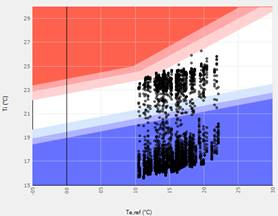

An “ATG Chart” contains thermal comfort points as a function of the mean outside air temperature of the last three days. This Dutch standard is meant to give extra dimensions to the “GTO” method. The PMV method is useable for thermal comfort situations with extremely high metabolisms or clothing values. An ATG can be used for buildings with great or small user influence, and can be used for buildings with open or enclosed facades.
Defines from which room the data will be sued to generate
the ATG graph
|
|
You can view only one room at a time in the graph. NOTE: Only the calculated areas are displayed. If the desired room is not present in the list, then it has not been calculated. |
Defines the period over which the ATG graph will be
displayed
•The Total period is over the total period for which you have calculated. This period is defined by the selection of the Climate File.
•The Usage Period displays only the period of time when the building is in use. Defined in the Climate File, and linked to the areas Schedule of IHG viewed over the entire building.
Specifies on what temperatures the ATG graph should
be based.
•Comfort temperature. Displays the results based on the comfort temperature for the room.
•Air temperature. Displays the results based on the aur temperature for the room
Specifies whether the ATG graph should be displayed
according to alpha or beta guidelines
•Alpha. Building / climate type Alpha
•Beta. Building / climate type Beta
Here you specify whether to display the ATG results as a
graph or as a table.
•Chart. Displays the ATG graph.
•Timesheet. Provides an overview per hour in tabular form.

This selection controls what you want to show in the table, the underheating hours, or the overheating hours.
The three percentages refer to the three building classes:
•90% - Class A building, where 90% of the users accepts the indoor climate;
•80% - Class B building, where 80% of the users accepts the indoor climate;
•65% - Class C building, where 65% of the users accepts the indoor climate.
|
BS |
ISSO Publication 32 (2011), Section 6.4 Design Criteria for humidity http://www.issodigitaal.nl/?action=login&externalaction=linkmanager&id=docs/publicatie/32/6.html/6.4 |
|
|
ISSO Publication 74 Thermal comfort (2004) Chapter 9 New performance indicator: ATG http://www.issodigitaal.nl/?action=login&externalaction=linkmanager&id=docs/publicatie/74/9.html |
|
|
ISSO little indoor (2005) Section 2.6 Requirements thermal comfort according to the ATG method |